The Role of Production Design in Creating Immersive Worlds
Production design encompasses the visual elements that contribute to the overall look and feel of a film, television show, play, or any other form of entertainment production. It involves creating the sets, props, costumes, and overall aesthetic that help bring the story and characters to life in a visually compelling way.
A skilled production designer is crucial to establishing the mood, tone, and time period of a production through their creative choices and attention to detail. By collaborating closely with directors, cinematographers, and other key members of the production team, the production designer helps to craft a cohesive visual narrative that enhances the storytelling experience for the audience.
The Importance of Attention to Detail
Attention to detail is a critical aspect of production design that can significantly impact the overall look and feel of a project. Every minute element, from the choice of props to the color palette used, plays a vital role in conveying the desired message to the audience. By meticulously considering even the smallest details, production designers ensure that everything works together seamlessly to create a cohesive and visually appealing final product.
Neglecting attention to detail can lead to inconsistencies and distractions that detract from the intended aesthetic and message of a film, TV show, or theater production. An oversight in set decoration or costume design, for example, can disrupt the audience’s immersion in the story and diminish the overall quality of the production. Therefore, by prioritizing attention to detail, production designers demonstrate their commitment to delivering a polished and professional end result.
• Attention to detail is crucial in production design
• Every small element impacts the overall look and feel of a project
• Props, color palette, set decoration all play a vital role
• Meticulous consideration ensures cohesion and visual appeal
Neglecting attention to detail can have negative consequences:
• Inconsistencies and distractions may arise
• Audience immersion in the story can be disrupted
• Overall quality of the production may suffer
Prioritizing attention to detail showcases professionalism:
• Demonstrates commitment to delivering a polished end result
• Helps maintain the intended aesthetic and message
• Enhances audience experience
Creating a Visual Language
Production design encompasses many elements, but one of its key components is creating a visual language that communicates the film’s message and enhances the storytelling. This visual language is developed through the careful selection of colors, textures, set design, props, and overall aesthetics that contribute to the film’s atmosphere and mood. By paying attention to every detail, production designers are able to craft a visual narrative that complements the script and conveys the intended emotions to the audience.
Through the use of symbolism, visual metaphors, and recurring motifs, production designers can establish a cohesive visual language that runs throughout the film. These visual cues not only add depth to the storytelling but also help to immerse the audience in the world of the film. Whether it’s through the use of specific colors to evoke certain emotions or the placement of recurring objects to convey a subliminal message, every aspect of the visual language is carefully constructed to enhance the overall cinematic experience.
What is production design?
Production design is the process of creating the overall visual look of a film, TV show, play, or other form of media. It involves designing sets, costumes, props, and other visual elements to help tell the story and create a specific atmosphere.
Why is attention to detail important in production design?
Attention to detail is crucial in production design because it helps create a cohesive and immersive world for the audience. Small details can make a big difference in how a scene or setting is perceived and can help to enhance the overall storytelling experience.
What is meant by creating a visual language in production design?
Creating a visual language in production design involves establishing a consistent and coherent visual style that helps convey the themes, mood, and tone of a project. This can include using specific colors, textures, shapes, and motifs to create a visual vocabulary that communicates key aspects of the story.





